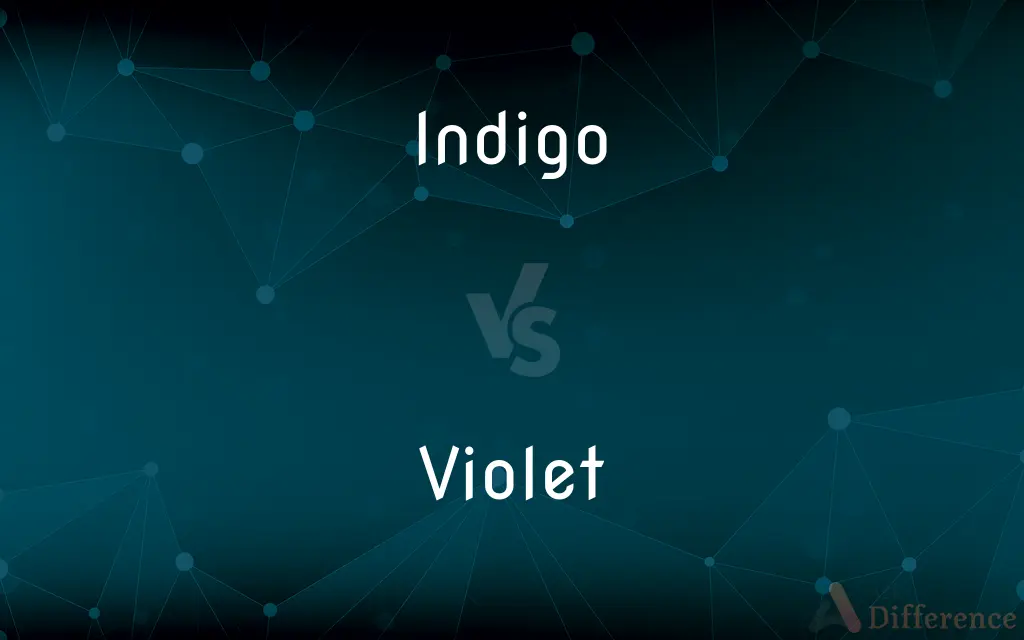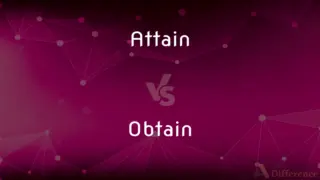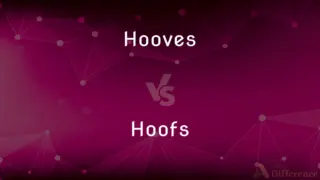Indigo vs. Violet — What's the Difference?
By Tayyaba Rehman — Updated on August 20, 2023
Indigo is a deep, rich blue color, while violet is a purple shade closer to blue.

Difference Between Indigo and Violet
Table of Contents
ADVERTISEMENT
Key Differences
Indigo and violet are both colors that exist on the spectrum of visible light. While they are often used interchangeably, they have distinct differences in their hues. Indigo is recognized as a color that is closer to blue and has a deeper, rich shade. It sits between blue and violet on the spectrum, and its hue gives it a sense of depth and mystery.
On the other hand, violet has a shade that leans more towards purple while still having a touch of blue. It's located at the end of the visible spectrum of light, right before ultraviolet light. Violet can appear brighter and more luminous compared to indigo, giving it a lighter feel and appearance.
The history of the words indigo and violet also reveals their distinctions. Indigo originates from the Indigofera plant, which was used in ancient times for dyeing fabric with its distinctive blue shade. Violet, on the other hand, gets its name from the violet flower, which boasts a purple-blue shade.
In the world of art and design, indigo and violet play unique roles. While indigo might be used for its calming and deep feel, violet might be chosen for its vibrant and bright touch. Both are significant in their own right, but when set side by side, their differences become clear.
Comparison Chart
Hue
Closer to blue with a deep shade.
Purple shade closer to blue.
ADVERTISEMENT
Origin of Name
Derived from the Indigofera plant used for dyeing.
Derived from the violet flower with a purple-blue shade.
Position on Spectrum
Sits between blue and violet.
Located at the end of the visible spectrum.
Feel and Appearance
Rich, deep, and mysterious.
Brighter, luminous, and vibrant.
Typical Uses
Often used for its calming effect in design.
Chosen for its bright and vibrant touch in art.
Compare with Definitions
Indigo
A deep blue color derived from the Indigofera plant.
The shirt was dyed in a beautiful indigo hue.
Violet
A color with a shade that leans towards purple, close to blue.
The flowers were a vivid violet, standing out in the garden.
Indigo
One of the colors of the visible spectrum, positioned between blue and violet.
The rainbow displayed a striking indigo band.
Violet
Any of various low-growing herbs of the genus Viola, having short-spurred, irregular flowers that are characteristically purplish-blue but sometimes yellow or white.
Indigo
Indigo is a deep color close to the color wheel blue (a primary color in the RGB color space), as well as to some variants of ultramarine, based on the ancient dye of the same name. The word "indigo" comes from the Latin for Indian as the dye was originally exported to Europe from India.
Violet
A small flower with a purple-blue color.
The meadow was dotted with delicate violet blooms.
Indigo
A dye used historically for fabric coloring.
Ancient civilizations treasured indigo for its rich tint.
Violet
A hue representing the highest frequency of visible light before ultraviolet.
Violet light is at the end of the visible spectrum.
Indigo
A shade often associated with intuition and the third eye in chakras.
She wore an indigo stone to enhance her intuition.
Violet
Any of several similar plants, such as an African violet.
Indigo
A blue dyestuff obtained from several plants belonging to very different genera and orders, such as, the woad, Isatis tinctoria (family Cruciferae), Indigofera suffroticosa, Indigofera tinctoria (family Leguminosae), Indigofera Anil, Nereum tinctorium, Polygonum tinctorium Ait. (family Polygonaceae), etc.; called also natural indigo. It is a dark blue earthy substance, tasteless and odorless, with a copper-violet luster when rubbed. Indigo does not exist in the plants as such, but is obtained by decomposition of the glycoside indican.
Violet
A color symbolizing royalty, luxury, and power.
The queen wore a violet robe to the ceremony.
Indigo
A blue dye obtained from plants or made synthetically
Violet
Any one of numerous species of small violet-colored butterflies belonging to Lycæna, or Rusticus, and allied genera.
Indigo
Any of various shrubs or herbs of the genus Indigofera in the pea family, having pinnately compound leaves and usually red or purple flowers in axillary racemes.
Violet
A shade that can evoke feelings of creativity and imagination.
The room was painted violet to inspire creativity.
Indigo
A dark blue crystalline compound, C16H10N2O2, that is obtained from these plants or produced synthetically and is widely used as a textile dye. Also called indigotin.
Violet
The hue at the short-wavelength end of the visible spectrum, evoked in the human observer by radiant energy with wavelengths of approximately 380 to 420 nanometers; any of a group of colors, reddish-blue in hue, that may vary in lightness and saturation.
Indigo
Any of several related plants, especially those of the genera Amorpha and Baptisia.
Violet
A plant or flower of the genus Viola, especially the fragrant Viola odorata; (inexact) similar-looking plants and flowers.
Indigo
The hue of that portion of the visible spectrum lying between blue and violet, evoked in the human observer by radiant energy with wavelengths of approximately 420 to 450 nanometers; a dark blue to grayish purple blue.
Violet
(figurative) A person thought to resemble V. odorata, especially in its beauty and delicacy.
Indigo
A kind of deep blue, one of the seven prismatic colors.
Violet
A bluish-purple colour resembling that of most V. odorata.
Indigo
Having the color of, pertaining to, or derived from, indigo.
Violet
Clothes and (ecclesiastical) vestments of such a colour.
Indigo
Deciduous subshrub of southeastern Asia having pinnate leaves and clusters of red or purple flowers; a source of indigo dye
Violet
(perfumes) The characteristic scent of V. odorata.
Indigo
A color that often represents depth and mystery.
The indigo night sky was filled with stars.
Violet
Having a bluish-purple colour.
Indigo
A purplish-blue colour
Violet
Any plant or flower of the genus Viola, of many species. The violets are generally low, herbaceous plants, and the flowers of many of the species are blue, while others are white or yellow, or of several colors, as the pansy (Viola tricolor).
Indigo
An indigo-colored dye obtained from certain plants (the indigo plant or woad), or a similar synthetic dye.
Violet
The color of a violet, or that part of the spectrum farthest from red. It is the most refrangible part of the spectrum.
Indigo
An indigo plant, such as from species in genera Indigofera, Amorpha (false indigo), Baptisia (wild indigo), and Psorothamnus and Dalea (indigo bush).
Violet
In art, a color produced by a combination of red and blue in equal proportions; a bluish purple color.
Indigo
Having a deep purplish-blue colour
Violet
Dark blue, inclining to red; bluish purple; having a color produced by red and blue combined.
Indigo
A blue-violet color
Violet
A variable color that lies beyond blue in the spectrum
Violet
Of a color midway between red and blue
Violet
Syn of onion.
Violet
Any of numerous low-growing small-flowered violas
Common Curiosities
What are the primary hues of indigo and violet?
Indigo primarily possesses a deep blue hue, while violet leans more towards a purple shade that is still close to blue.
How do indigo and violet differ in the light spectrum?
Indigo sits between blue and violet on the visible spectrum, whereas violet represents the highest frequency of visible light right before ultraviolet.
From where do the names indigo and violet originate?
Indigo gets its name from the Indigofera plant used for dyeing, while violet is named after the violet flower with a purple-blue shade.
Which color, indigo or violet, is typically brighter?
Violet tends to appear brighter and more luminous compared to the deep and rich shade of indigo.
Are indigo and violet used in any cultural or spiritual practices?
Yes, indigo is linked with the third eye in chakras, symbolizing intuition, while violet represents the crown chakra, associated with cosmic consciousness.
Which is more commonly used in fashion, indigo or violet?
While both colors are used in fashion, indigo, especially in its dye form, has historically been a prevalent color for fabrics.
How do indigo and violet relate to human psychology?
Indigo is often associated with intuition and depth, while violet can symbolize royalty, luxury, and creativity.
Are indigo and violet the same in art and design?
No, indigo is often used for its calming and mysterious effect, while violet is chosen for its vibrant and bright touch.
Is the violet flower the same color as the shade violet?
While the violet flower does have a purple-blue shade, it might not exactly match the hue known as violet.
What is the historical significance of indigo?
Indigo has a rich history, especially as a dye derived from the Indigofera plant, valued in ancient civilizations.
Share Your Discovery

Previous Comparison
Attain vs. Obtain
Next Comparison
Hooves vs. HoofsAuthor Spotlight
Written by
Tayyaba RehmanTayyaba Rehman is a distinguished writer, currently serving as a primary contributor to askdifference.com. As a researcher in semantics and etymology, Tayyaba's passion for the complexity of languages and their distinctions has found a perfect home on the platform. Tayyaba delves into the intricacies of language, distinguishing between commonly confused words and phrases, thereby providing clarity for readers worldwide.














































